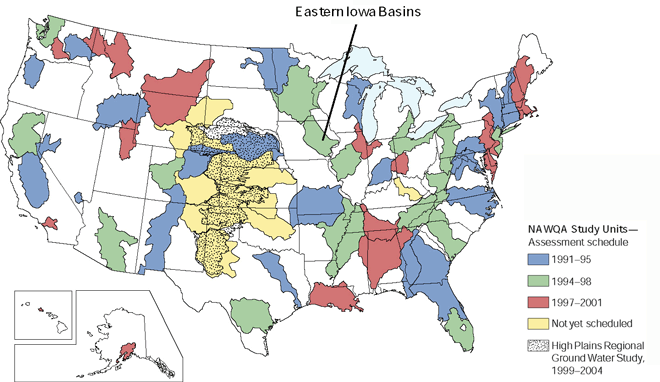NATIONAL WATER-QUALITY ASSESSMENT PROGRAM
THIS REPORT summarizes major findings about water quality in the Eastern Iowa Basins that emerged from an assessment conducted between 1996 and 1998 by the U.S. Geological Survey (USGS) National Water-Quality Assessment (NAWQA) Program. Water quality is discussed in terms of local and regional issues and compared to conditions found in all 36 NAWQA study areas, called Study Units, assessed to date. Findings also are explained in the context of selected national benchmarks, such as those for drinking-water quality and the protection of aquatic organisms. The NAWQA Program was not intended to assess the quality of the Nationís drinking water, such as by monitoring water from household taps. Rather, the assessments focus on the quality of the resource itself, thereby complementing many ongoing Federal, State, and local drinking-water monitoring programs. The comparisons made in this report to drinking-water standards and guidelines are only in the context of the available untreated resource. Finally, this report includes information about the status of aquatic communities and the condition of in-stream habitats as elements of a complete water-quality assessment.
Many topics covered in this report reflect the concerns of officials of State and Federal agencies, water-resource managers, and members of stakeholder groups who provided advice and input during the Eastern Iowa Basins assessment. Basin residents who wish to know more about water quality in the areas where they live will find this report informative as well.
 |
THE NAWQA PROGRAM seeks to improve scientific and public understanding of water quality in the Nationís major river basins and ground-water systems. Better understanding facilitates effective resource management, accurate identification of water-quality priorities, and successful development of strategies that protect and restore water quality. Guided by a nationally consistent study design and shaped by ongoing communication with local, State, and Federal agencies, NAWQA assessments support the investigation of local issues and trends while providing a firm foundation for understanding water quality at regional and national scales. The ability to integrate local and national scales of data collection and analysis is a unique feature of the USGS NAWQA Program.
The Eastern Iowa Basins is one of 51 water-quality assessments initiated since 1991, when the U.S. Congress appropriated funds for the USGS to begin the NAWQA Program. As indicated on the map, 36 assessments have been completed, and 15 more assessments will conclude in 2001. Collectively, these assessments cover about one-half of the land area of the United States and include water resources that are available to more than 60 percent of the U.S. population.
| Table of Contents || Previous Section || Next Section || Glossary U.S. Geological Survey Circular 1210 Suggested citation:
|

